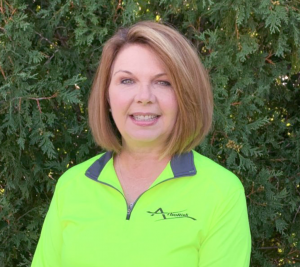Chainsaw Safety
As an arborist, you quickly found out that operating a chainsaw is a prerequisite for the job. That being said, the actual prerequisite is SAFELY operating a chainsaw. Keep in mind that most of our chainsaw injuries result in 110 stitches or more! Listed below are a few guidelines that you may have forgotten or you may not know.
Never walk around the job site with a chainsaw running, use the chain brake when taking one to three steps. If you have to walk farther, turn it off and carry the saw by the handle with the bar pointing backwards.
When in a tree with a chainsaw always use two hands. Most injuries in this situation are to the left hand, and in 97% percent of the accidents, the operator was using the saw with one hand. If you are down on the ground, use the saw that requires two hands; do not use your top handled saw. Make sure you are secure in your footing while operating that chainsaw – two feet, planted securely on the ground. If you are in the tree, make sure you are tied in and use a second means of attachment such as a lanyard, to keep yourself steady. Whether in the tree or on the ground, make sure the chain brake is engaged and do not drop start the saw. Brace it on a limb in a tree, or, when on the ground, put the saw down and use your foot on the handle.
Make sure you are secure in your footing while operating that chainsaw – two feet, planted securely on the ground. If you are in the tree, make sure you are tied in and use a second means of attachment such as a lanyard, to keep yourself steady. Whether in the tree or on the ground, make sure the chain brake is engaged and do not drop start the saw. Brace it on a limb in a tree, or, when on the ground, put the saw down and use your foot on the handle.
Always make sure your thumbs are secured, tucked in, or wrapped around the handles when using a chainsaw. Always be aware in what position you are running the chainsaw so as to avoid kickback. Never operate a chainsaw over shoulder height. Also, if you have long hair, make sure it is tied back.
When you are ready to start chainsaw operations, notify your crew. If they need to get your attention, they should either wait until you are finished or walk in front of you about 5 feet away and signal that you need to stop. Tell your crew to never tap you from behind when you are operating a chainsaw.
Spread out a small tarp to set up a fueling station on the grass or out of the way of pedestrians and cars. Never refuel on the sidewalk or the roadway.
Always wear safety glasses, hardhat (with or without a face shield is acceptable), and ear plugs. Repetitive use of a chainsaw running at 85 or more decibels WILL harm your hearing ability. Besides the other PPE that you must wear, wear you chaps, and remember that the groin area is not protected with chaps.
Because our industry works with dangerous motorized equipment, carry a trauma kit for the injuries. Climbers should carry a tourniquet up in the tree and one ground person should carry a tourniquet. This might seem like overdoing it, but, as I stated above, most of our chainsaw injuries result in 110 stitches or more. Everyone should learn how to apply a tourniquet and also practice one-handed for applying a tourniquet. Climbers are all alone in the tree and a tourniquet just may save their life.
For an in-depth look at chainsaw safety, sign up for our webinar on March 19 from Noon – 4pm Central time. Earn 4 ISA and CTSP CEUs by attending. Learn more at StreamsideGreen.com.
As always, stay safe out there, enjoy your industry, and go home healthy to your family!

Written by: Dawn Thierbach

& Margaret Hebert

0 Comments